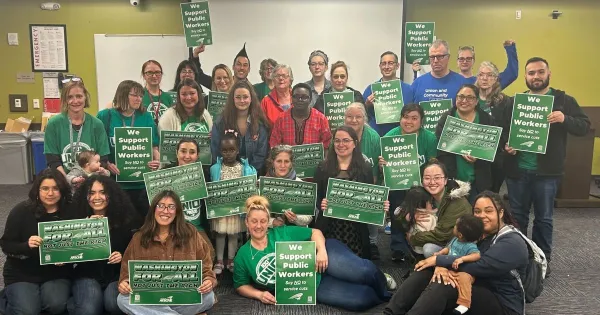Layoff Resources and the Fight Ahead

Jump to Layoff Resources Here
In Higher Ed? Jump to Fights Against Furloughs and Layoffs Here
Find Legislative Victories here
Layoffs and Washington’s Upside-Down Tax Code
The largest budget deficit in Washington state history — $16 billion — occurred at a time of unprecedented wealth inequality.
The top 10 percent hold 69 percent of wealth. The bottom 50 percent hold 3 percent of wealth, according to the nonpartisan Congressional Budget Office.
Just three Washington residents have a combined net worth over $300 billion.
Because there is no state income tax, all their skyrocketing wealth doesn’t go toward the services we provide, or the income our families depend on, or the healthcare we depend on when we get sick.
On the contrary, because 50% of our state budget is funded by sales tax, any slight downturn in consumer spending by lower and middle-income Washingtonians (due to inflation, tariffs, you name it) results in state revenue falling off a cliff, and our elected officials putting our jobs, benefits, and pay on the chopping block.
This time we forced the legislature to do things a little differently.
Furloughs or Layoffs: A False Choice
This budget crisis was worse than the COVID crisis, worse than the Great Recession, where $10 billion in cuts were made. The question was not if there would be layoffs, just how many, and if our raises and health benefits were also at risk.
Some agencies are actively spreading the word that the layoffs they are instituting are due to our members defeating furloughs.
Here are the facts: We avoided mass layoffs by winning $9 billion in new revenue, not by fighting off furloughs.
Furloughs would have “saved” the state approximately $300 million, which is nothing in the context of a $77.9 billion 2-year budget with a $16 billion hole to fill.
Our elected member leaders decided that it made little sense to accept furloughs in the off-chance that those minimal savings would be applied to reduce the number of layoffs to our members.
Layoffs and furloughs are not mutually exclusive.
We could easily have had mass layoffs and furloughs and had our healthcare rates jacked up. And those left working would be doing so for less. So, more work for less money. That was not acceptable.
We avoided all three by forcing the legislature to raise new revenue and find savings elsewhere. The legislature follows the path of least resistance, and our members made calls and wrote letters and rallied and put up a LOT of resistance.
Unlike previous crises, they didn’t balance the budget by not funding our raises and gutting our healthcare, which essentially mean permanent takeaways for ourselves and our families.
The employee responsibility of healthcare costs has never gone back down once raised. We kept it at 85% and 15% in the worst budget crisis in state history.
Loss of raises are also permanent. The 5% general wage increase the legislature wanted us to forego would not build into the base of your salary and would not compound for years to come.
Work to Be Done to Win a #WashingtonForAll
Make no mistake, proposals to cut $10 billion from the budget just like the Great Recession were on the table and being actively considered. In the end we landed on $9 billion in revenue over the next four years – much of it from progressive revenue sources – but not enough.
The hard truth remains:
No public sector job or service, no matter how vital, is safe until we fix our structural budget deficit and stop relying on the spending habits of poor and middle-income Washingtonians to fund services.
Your Contract, Your Voice
The fight for our next union contract is already underway. How much money there is to negotiate for when we begin fighting for our 2027-2029 contract a year from now has everything to do with:
- What federal cuts are made and how drastic they are
- The revenue forecasts in June and September, and
- If we're forced into a special legislative session this year
- If we defeat initiatives run this November by billionaires and corporate interests who will try to overturn the new revenue we just generated that saved countless WFSE member jobs, our raises and more
How many layoffs will there be?

State Government
In state government, agencies are allocated a pot of money and a number of full-time employees (FTEs). The agencies can use them as they wish.
Note that the exact number of layoffs will depend on the agency, the number of vacancies, and if they can cut elsewhere.
Higher Education
In higher education, the governor has much less control over how savings are implemented. Schools are still determining how they will address the cuts, and we are drawing a line in the sand where schools are trying to balance the budget on the backs of WFSE members.
We fought off furloughs in the legislature, now we need to fight them in higher education.
- At Seattle Colleges, WFSE members are organizing after management announced their attempt to implement furloughs. - Send a letter to fight furloughs at Seattle Colleges here.
- At Western Washington University, the school is actually trying to reopen the contract we just bargained and convinced the legislature to fund, presumably to take away the 5% general wage increase for 2025-2027. We’re fighting that, too.
- We’re actively fighting an attempt to close the Early Learning Center at Everett Community College. - Send a letter to stop the closure here.
Stay tuned for more ways our higher education members are standing up and fighting back.
Are you at Risk of a Layoff? Find Resources Here
Received Layoff Notice Already?
Additional resources:
Department of Retirement Systems Access your member account/s, learn about eligibility, and more here: www.drs.wa.gov
Employment Security Department
Apply for unemployment benefits, get help with your resume and job-seeking, and enroll in the Dislocated Worker Program here: https://esd.wa.gov/jobs-and-training/find-job/services-laid-workers.
Public Employees Benefits Board – Health Coverage
Although your employer will send you information about this, PEBB-eligible employees are eligible for continuing coverage upon separation. Learn more about the options and your rights at: https://www.hca.wa.gov/pebb-benefits-admins/pebb-benefits.
Human Resources
Contact your agency’s Human Resources department and ask about:
- Resources for out-of-state employees
- All benefit and payroll questions
- Layoff options (meaning alternate positions you may qualify for)
- Employment opportunities in your agency/college/university
- Access to layoff lists and, for General Government, the General Government Transition Pool (lists you can be placed on for future re-employment)
- Your current leave balances:
- Vacation leave is paid upon separation
- Sick leave remains in place for up to 5 years after separation and is reinstated if you return during that time (you cannot cash it out as a result of layoff)
- Compensatory time should be cashed out/used prior to separation
- Personal holidays and leave days should be used prior to separation
Employee Assistance Program
The Employee Assistance Program (EAP) offers counseling services, along with a wide variety of electronic resources on topics ranging from stress management to financial counseling here: https://des.wa.gov/services/employee-assistance-program.
Department of Social and Health Services
Learn more about a variety of income-based programs available to support the cash, food, and medical needs of Washingtonians here: https://www.dshs.wa.gov/food-cash-medical. Out-of-state employees should seek resources in their state of residence.
Washington State Labor Council
The Washington State Labor Council’s workforce development department can assist with advocating for laid off workers and helping them access state and federal programs available to assist with finding employment and pursuing training opportunities. See: https://www.wslc.org/workforce-development/.
Washington Career Bridge
Explore new career options and locate education and training opportunities, including resources to help with paying for school here: https://www.careerbridge.wa.gov/.
Union Member Only Benefits
Access union members’ only benefits related to money and credit, education, home mortgage, auto and insurance, health, and legal services here: https://www.afscme.org/member-resources/afscme-advantage and https://www.wfse.org/member-benefits. You must be a member to access these benefits. If you are not, and wish to join, visit https://www.wfse.org/join from a personal device.
Have questions or need representation?
Contact our Union’s Member Connection Center at 1-833-MCC-WFSE (833-622-9373) or email [email protected]
